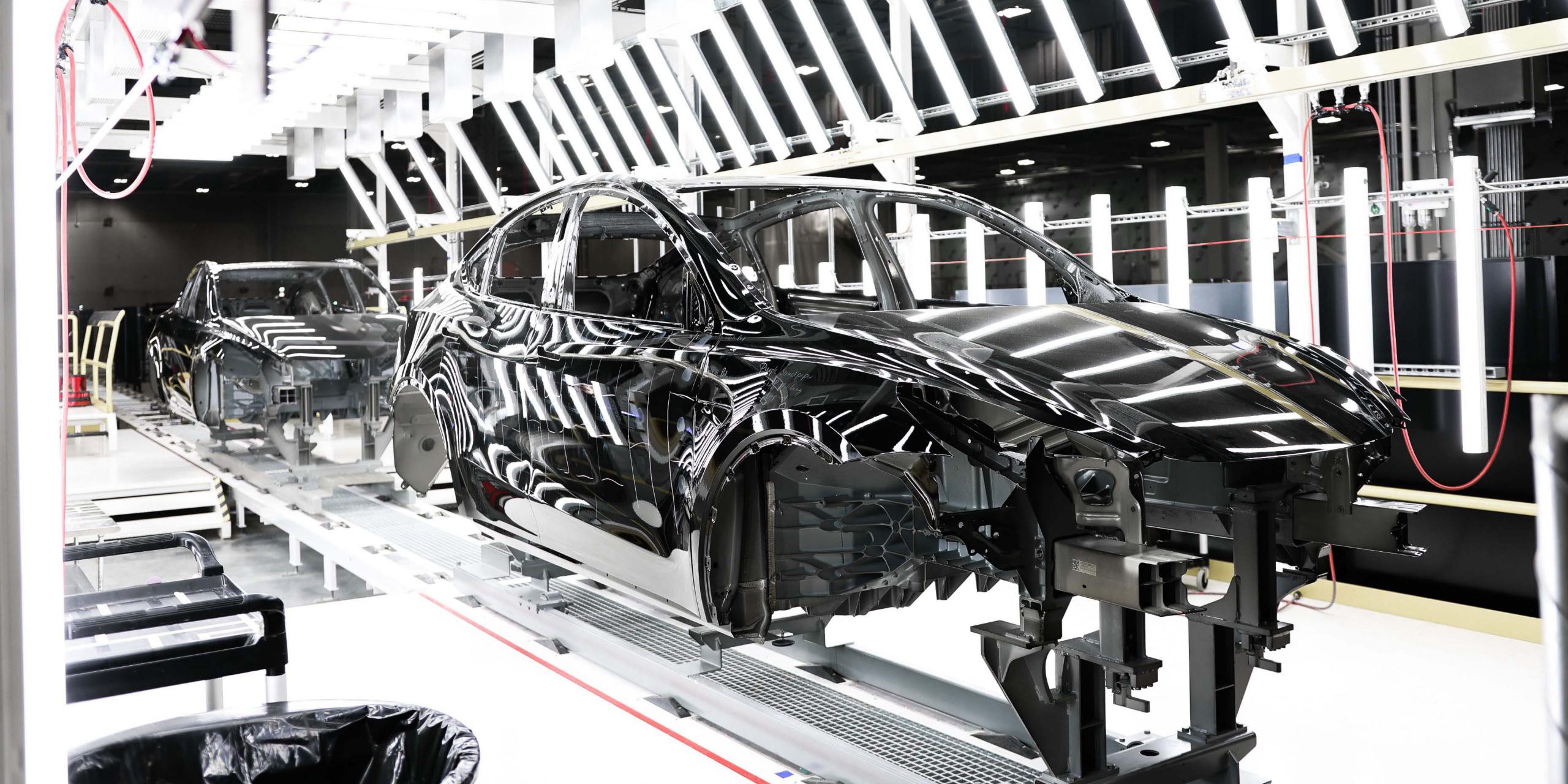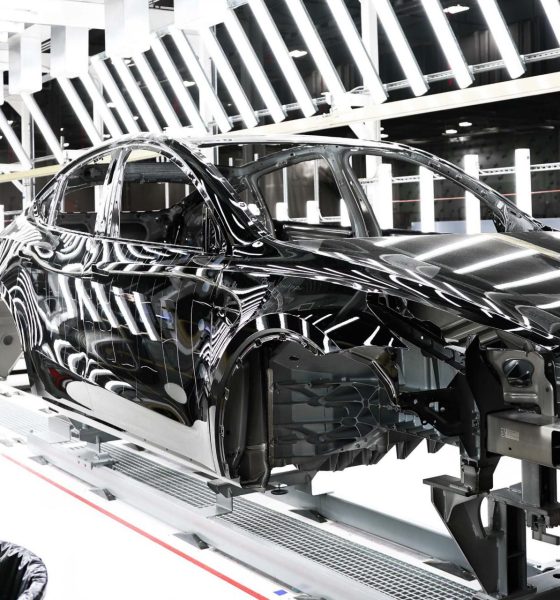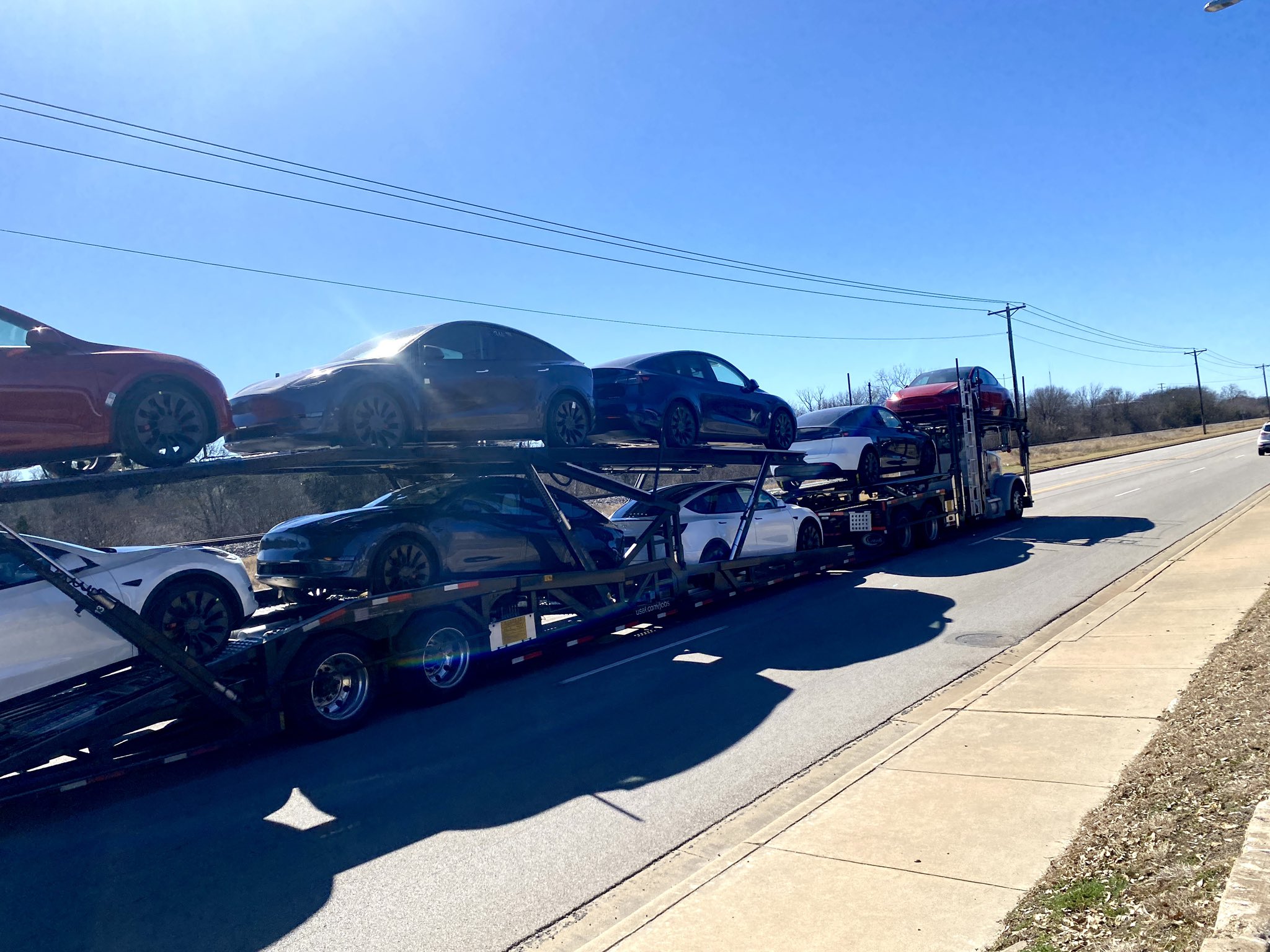

News
Tesla Model Y from Giga Texas is just one EPA approval away from first deliveries
Hundreds of Tesla Model Y all-electric crossovers have been spotted in the lots of Gigafactory Texas in the past few weeks, with some being spotted on haulers to be driven to destinations not known. However, haulers will likely be back soon for another logistics mission: to pick up the “Austin-made” Model Ys and take them to customers for delivery.
Tesla will be able to begin delivering units of its Austin-made Model Y all-electric crossover from Gigafactory Texas following the EPA approval of the vehicle, the agency told Teslarati. Currently, the Model Y from Gigafactory Texas is being produced with Tesla’s newest 4680 battery cells and new structural battery pack, has not gained its Certificate of Conformity, a document needed for a vehicle to be introduced into commerce.
Certificates of Conformity are effectively approval by the EPA that a vehicle can enter the stream of commerce. If it is introduced into commerce, the vehicle must have a Certificate of Conformity. The certifications are valid for a single model year, and new model year vehicles make their way to the EPA’s testing facility in Ann Arbor, Michigan every year to confirm they align with the EPA’s emissions standards.
“Prior to offering a vehicle for sale, all carlines in the Light-duty sector must be certified and Fuel Economy test data representing each model type must be submitted to EPA,” the EPA said to Teslarati in a statement. “EPA can confirm that Tesla has received a Certificate of Conformity for the 2022 Model Y Long Range AWD, Model Y Performance AWD (Test Group NTSLV00.0L2Y) and a Certificate for the Model Y RWD (Test Group NTSLV00.0L1Y).” These test groups were certified by the EPA last year, with the 2022 Model Y Long Range AWD and Performance variants gaining their Certificate of Conformity on November 1, 2021. It does not expire until December 31, 2022. The 2022 Model Y RWD, which is the variant that Tesla ultimately did not sell, gained its Certificate of Conformity from the EPA on September 28.
(Credit: Jeff Roberts)
Tesla’s Model Y made in Austin will also be a 2022 Model Y, which would mean it would technically align with the EPA’s Certificates of Conformity, especially as the geographic location of manufacture does not determine whether a vehicle conforms to the EPA’s standards or not. “EPA does not use the build location as a descriptor for a new test group or Certificate of Conformity,” the agency said. Instead, updates in the vehicle’s battery pack can prompt the EPA to consider certifying a vehicle again, even if the changes occur to a car in the same model year. However, the changes made to the vehicle prompted the EPA to certify the Austin-made Model Y separately.
In its 2017 document titled, “EPA Test Procedures for Electric Vehicles and Plug-in Hybrids,” the agency says that Confirmatory Testing for vehicles with the same model year is determined on a case-by-case basis, and the EPA can make a choice to certify a vehicle based on the changes:
“Currently, EPA performs confirmatory testing on all new light-duty electric vehicles and plug-in hybrid vehicles at EPA’s emission testing laboratory in Ann Arbor Michigan. If the manufacturer makes changes to an EV or PHEV that was previously tested at EPA, EPA will decide on a case-by-case basis whether additional EPA confirmatory testing is needed.”
What were the changes Tesla made exactly? The EPA confirmed to us that it could not comment on the status “of preproduction vehicles that are pending new emissions certification until manufacturers introduce them into commerce,” which means the Model Y’s changes are confidential until the car earns its Certificate of Conformity. Tesla did not respond to our inquiries to clarify why the vehicle needed to go through the EPA’s conformity procedure once again. However, Tesla’s most recent Earnings Call provided plenty of color to what the changes that prompted a new certification process likely are, and it has to do with Tesla’s 4680 battery cell.
The Battery Pack likely required the EPA to certify the Model Y once again
During the Q4 2021 Earnings Call, Tesla said that “after final certification of Austin-made Model Y, we plan to start deliveries to customers.” Additionally, during the Earnings Call CEO Elon Musk stated that Tesla was “building the Model Ys with the structural battery pack and the 4680 cells, and we’ll start delivering after final certification of the vehicle, which should be fairly soon.” Read More.
Previous builds of the Model Y, even 2022 model year vehicles, which were built at the Fremont Factory, have not yet used Tesla’s 4680 battery pack or the structural battery pack. Instead, Model Ys built at Fremont in the United States have used the automaker’s previous cell chemistry, the 2170 cell. When the EPA certified Tesla’s 2022 model year vehicles in August 2021, the certifications were for the previous battery pack. Read More.
Tesla Model Y from Giga Texas will equip Structural Battery Pack, 4680 cells
The 4680 batteries differ significantly from the 2170 cell in power, range, and efficiency. Therefore, the Model Y from Texas will have ratings that are substantially different from previous builds from Fremont. The Model Y from Austin needs eMPG ratings for FuelEconomy.gov and Monroney stickers.
Once Tesla is granted a Certificate of Conformity for Model Ys that are set to be produced at Gigafactory Texas, the automaker will be able to deliver the vehicles to customers.
Documents obtained by Teslarati show Tesla’s application to have the Model Y’s AWD and Performance variants certified together, while the RWD build of the car was certified separately. The documents state that each variant of the car conformed with California Air and Resource Board (CARB) standards, as well as Federal Emissions Standards that States which do not align with the CARB standards utilize. Texas withdrew its intentions to adopt CARB standards in 2007, State documents revealed.
States that have adopted CARB standards are New York, Massachusetts, Vermont, Maine, Pennsylvania, Connecticut, Rhode Island, Washington, Oregon, New Jersey, Maryland, Delaware, and most recently, Colorado, which adopted the standards this year.
How long until the Tesla Model Y from Gigafactory Texas is approved by the EPA?
The EPA cannot predict the timing of the certification process, and it varies from vehicle to vehicle. Rough timeframes are available by determining when Tesla submitted an application for a vehicle and when the vehicle gained its Certificate of Conformity.
Tesla’s application for the 2022 Model Y Long Range AWD and Performance variants is dated for October 21, while the Certificate of Conformity is dated November 1. However, this vehicle had a previous model year and utilized the same battery pack. The timeframe may be quicker as the 4680 pack has not been previously tested by the EPA for a passenger vehicle.
When Tesla submitted its application for the 2021 Model Y, it was the first certification process for the vehicle. Tesla submitted the application on December 13, 2019, with the Model Y gaining its Certificate of Conformity about a month later on January 8.
If Tesla submitted its application for the new Model Y on January 26 when it announced it was awaiting certification, deliveries could be approved within the coming days.
4680 Battery Cell
In September 2020, Tesla held “Battery Day” to unveil a new cell and manufacturing design that would increase vehicle safety and structural integrity. Musk unveiled the 4680 cell, a new electric vehicle battery capable of more range, power, and performance while offering a longer life cycle. Tesla has been producing the cell in volume at a facility known as Kato Road near the company’s Fremont factory in Northern California. Until now, no customer has driven a Tesla vehicle equipping the 4680 cell. The Model Y built at the Texas factory will be the first Tesla vehicle to utilize the new 4680 battery pack. Read More.
The vehicle will also utilize Tesla’s structural battery pack, the automaker confirmed. The structural battery pack uses engineering similar to an aircraft wing to use negative mass to increase structural integrity and density. The packs will also use a structural adhesive and flame retardant, attaching cells to the floor and ceiling of the pack, increasing stiffness and preventing major deformation in the event of a crash. Read More.
I’d love to hear from you! If you have any comments, concerns, or questions, please email me at joey@teslarati.com. You can also reach me on Twitter @KlenderJoey, or if you have news tips, you can email us at tips@teslarati.com.

News
Tesla FSD fleet is nearing 7 billion total miles, including 2.5 billion city miles
As can be seen on Tesla’s official FSD webpage, vehicles equipped with the system have now navigated over 6.99 billion miles.

Tesla’s Full Self-Driving (Supervised) fleet is closing in on almost 7 billion total miles driven, as per data posted by the company on its official FSD webpage.
These figures hint at the massive scale of data fueling Tesla’s rapid FSD improvements, which have been quite notable as of late.
FSD mileage milestones
As can be seen on Tesla’s official FSD webpage, vehicles equipped with the system have now navigated over 6.99 billion miles. Tesla owner and avid FSD tester Whole Mars Catalog also shared a screenshot indicating that from the nearly 7 billion miles traveled by the FSD fleet, more than 2.5 billion miles were driven inside cities.
City miles are particularly valuable for complex urban scenarios like unprotected turns, pedestrian interactions, and traffic lights. This is also the difference-maker for FSD, as only complex solutions, such as Waymo’s self-driving taxis, operate similarly on inner-city streets. And even then, incidents such as the San Francisco blackouts have proven challenging for sensor-rich vehicles like Waymos.
Tesla’s data edge
Tesla has a number of advantages in the autonomous vehicle sector, one of which is the size of its fleet and the number of vehicles training FSD on real-world roads. Tesla’s nearly 7 billion FSD miles then allow the company to roll out updates that make its vehicles behave like they are being driven by experienced drivers, even if they are operating on their own.
So notable are Tesla’s improvements to FSD that NVIDIA Director of Robotics Jim Fan, after experiencing FSD v14, noted that the system is the first AI that passes what he described as a “Physical Turing Test.”
“Despite knowing exactly how robot learning works, I still find it magical watching the steering wheel turn by itself. First it feels surreal, next it becomes routine. Then, like the smartphone, taking it away actively hurts. This is how humanity gets rewired and glued to god-like technologies,” Fan wrote in a post on X.
News
Tesla starts showing how FSD will change lives in Europe
Local officials tested the system on narrow country roads and were impressed by FSD’s smooth, human-like driving, with some calling the service a game-changer for everyday life in areas that are far from urban centers.

Tesla has launched Europe’s first public shuttle service using Full Self-Driving (Supervised) in the rural Eifelkreis Bitburg-Prüm region of Germany, demonstrating how the technology can restore independence and mobility for people who struggle with limited transport options.
Local officials tested the system on narrow country roads and were impressed by FSD’s smooth, human-like driving, with some calling the service a game-changer for everyday life in areas that are far from urban centers.
Officials see real impact on rural residents
Arzfeld Mayor Johannes Kuhl and District Administrator Andreas Kruppert personally tested the Tesla shuttle service. This allowed them to see just how well FSD navigated winding lanes and rural roads confidently. Kruppert said, “Autonomous driving sounds like science fiction to many, but we simply see here that it works totally well in rural regions too.” Kuhl, for his part, also noted that FSD “feels like a very experienced driver.”
The pilot complements the area’s “Citizen Bus” program, which provides on-demand rides for elderly residents who can no longer drive themselves. Tesla Europe shared a video of a demonstration of the service, highlighting how FSD gives people their freedom back, even in places where public transport is not as prevalent.
What the Ministry for Economic Affairs and Transport says
Rhineland-Palatinate’s Minister Daniela Schmitt supported the project, praising the collaboration that made this “first of its kind in Europe” possible. As per the ministry, the rural rollout for the service shows FSD’s potential beyond major cities, and it delivers tangible benefits like grocery runs, doctor visits, and social connections for isolated residents.
“Reliable and flexible mobility is especially vital in rural areas. With the launch of a shuttle service using self-driving vehicles (FSD supervised) by Tesla in the Eifelkreis Bitburg-Prüm, an innovative pilot project is now getting underway that complements local community bus services. It is the first project of its kind in Europe.
“The result is a real gain for rural mobility: greater accessibility, more flexibility and tangible benefits for everyday life. A strong signal for innovation, cooperation and future-oriented mobility beyond urban centers,” the ministry wrote in a LinkedIn post.
News
Tesla China quietly posts Robotaxi-related job listing
Tesla China is currently seeking a Low Voltage Electrical Engineer to work on circuit board design for the company’s autonomous vehicles.

Tesla has posted a new job listing in Shanghai explicitly tied to its Robotaxi program, fueling speculation that the company is preparing to launch its dedicated autonomous ride-hailing service in China.
As noted in the listing, Tesla China is currently seeking a Low Voltage Electrical Engineer to work on circuit board design for the company’s autonomous vehicles.
Robotaxi-specific role
The listing, which was shared on social media platform X by industry watcher @tslaming, suggested that Tesla China is looking to fill the role urgently. The job listing itself specifically mentions that the person hired for the role will be working on the Low Voltage Hardware team, which would design the circuit boards that would serve as the nervous system of the Robotaxi.
Key tasks for the role, as indicated in the job listing, include collaboration with PCB layout, firmware, mechanical, program management, and validation teams, among other responsibilities. The role is based in Shanghai.
China Robotaxi launch
China represents a massive potential market for robotaxis, with its dense urban centers and supportive policies in select cities. Tesla has limited permission to roll out FSD in the country, though despite this, its vehicles have been hailed as among the best in the market when it comes to autonomous features. So far, at least, it appears that China supports Tesla’s FSD and Robotaxi rollout.
This was hinted at in November, when Tesla brought the Cybercab to the 8th China International Import Expo (CIIE) in Shanghai, marking the first time that the autonomous two-seater was brought to the Asia-Pacific region. The vehicle, despite not having a release date in China, received a significant amount of interest among the event’s attendees.








